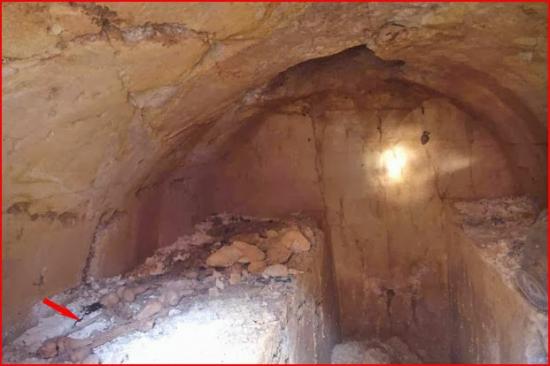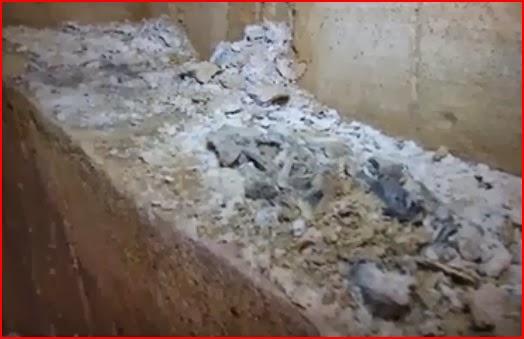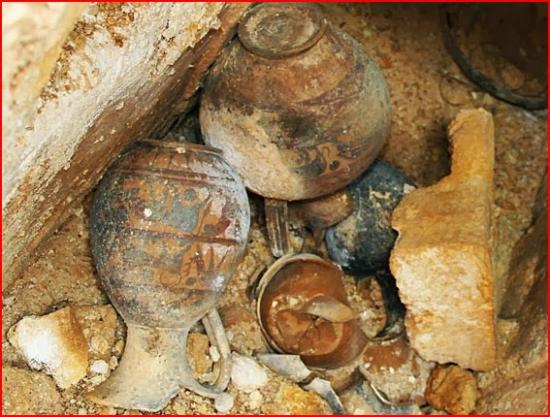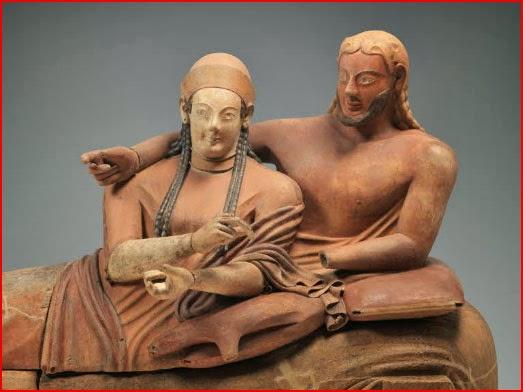Quick Sex Change in Etruria
Source - http://networkedblogs.com/PMCgA
Just last month, Italian archaeologists discovered a remarkable, intact Etruscan burial at Tarquinia in the heartland of Tuscany. On 21 September, Alessandro Mandolesi, Professor of Etruscology and Italic Antiquity at the University of Torino, and his team removed a perfectly sealed stone slab door to enter the newly discovered rock-cut tomb. This is what they saw.

The skeleton on the left platform with the spear beside the body (marked by arrow) The complete skeleton of an individual resting on a stone bed on the left (Rossella Lorenzi). Photo credit: Massimo Legni/SBAEM/UNITO via Discovery News.com
Within the burial chamber was the complete skeleton of an individual resting on a stone platform with an iron spear lying alongside the body. Brooches on the chest indicated that the man (for, presumably, the spear makes the man) had been dressed for his funeral in a cloak fastened by those brooches. Gold jewellery and engraved sealstones were found, while a still unopened jewellery box on the opposite narrower platform hints at more treasures to come. On that platform, too, were the incinerated remains of a second person, presumably his wife.
Cleaned up a bit, her pile of ash and burnt bones looked like this:

The tomb and its contents date to ca. 610-600 BCE. The fact that the burial chamber lies on the very flank of the giant tumulus of the so-called Queen’s Tomb, dated a little earlier to mid-7th century BCE, indicates that it belonged to one of the princes of Tarquinia, who would have been closely related to the founders of the Queen’s Tomb.* It was tempting (and who can resist the temptation?) to connect this new-found prince with Tarquinius Priscus, the legendary fifth king of Rome from 616 to 579 BCE.

Imported Corinthian vases confirm late-7th c. BCE date. Grave goods, including large Greek Corinthian vases and precious ornaments, on the floor of the tomb (Rossella Lorenzi).Photo credit: Photo credit: Massimo Legni/SBAEM/UNITO via Discovery News.com
In an interview with the Italian newspaper Corriere della Sera, Prof. Mandolesi said that the last time a comparable tomb had been discovered intact was more than 30 years ago, but that it collapsed before it could be excavated. “It’s a unique discovery, as it is extremely rare to find an inviolate Etruscan tomb of an upper-class individual." And he added, "This one is completely intact and may well reveal further surprises."
A rare find indeed.
The story had everything: royalty, rarity, and mysterious Etruscans. It lacks only one thing. There is no prince.
Or, at least, it's not his skeleton.
Now you see him, now you don't.
“There are two [stone] platforms," Prof. Mandolesi said, "one bigger and the other narrower. It was probably for a couple, especially if you consider the objects. The point of an iron spear is male...while other objects such as a jewellery box are female."
Not necessarily, my good sir.
Surprise!
While jewellery boxes are indeed gendered female (although Etruscan men wore jewellery, too), all that means is that there was a woman in the tomb. Since Etruscan tombs are family tombs, that's no surprise. What is a surprise, however, is that the skeleton with the lance is female. Osteological analysis (reported on 26 September) indicates that the body on the bigger platform was that of a woman who was 35 - 40 years old when she died. And the incinerated corpse on the narrower platform belonged to a male. In other words, gendering the grave goods got it backwards.
"It's not usual to find the body of a woman with a lance," explained Mandolesi. "After having had the results of the anthropological analysis of the skeleton, and having found the [ashes of] the male, we have a clearer picture of the situation. The lance, in all probability, was deposited as a symbol of the union between the two deceased." (my translation and my italics).
So the newly-identified lady still doesn't get credited with her own lance. The thought doesn't even arise that it might be a symbol of her power and authority rather than the weapon of a warrior. Downplayed like this, this major revision of the original story dropped like a stone into the media pool without leaving so much as a bubble behind.**
Why is it so difficult to understand that the ruling class of Etruscan society was made up of both men AND women?

Le Sarcophage des époux. Painted clay sarcophagus from Caere (Cerveteri), ca. 520-510 BCE. Photo credit: Louvre Museum, dist. RMN/Phillpe Fuzeau.
And that some Etruscan women were tough as old boots?
Their exceptionally emancipated status is perfectly clear from the surviving stories that harp on their scandalous behaviour. The Greeks and Romans, who wrote everything that has survived, were enemies of the Etruscans and despised them for their way of life. And they certainly did not like what they saw of Etruscan women's relatively free and easy-going habits. Take Theopompus, for example, a Greek historian of the 4th c. BCE:
Sharing wives is an established Etruscan custom. Etruscan women take particular care of their bodies and exercise often, sometimes along with the men, and sometimes by themselves. It is not a disgrace for them to be seen naked. They do not share their couches [when dining] with their husbands but with the other men who happen to be present, and they propose toasts to anyone they choose. They are expert drinkers and very attractive.
The Etruscans raise all the children that are born, without knowing who their fathers are. The children live the way their parents live, often attending drinking parties and having sexual relations with all the women. It is no disgrace for them to do anything in the open, or to be seen having it done to them, for they consider it a native custom.
Lust, luxury, nudity, and indiscriminate whoopie-making. How unlike our dear Greek women, who know their place and stay in the women's quarters. The famous story of the Rape of Lucretia (told by Livy, writing at the turn of the 1st c. BCE/CE) starts off, too, with those notorious drinking parties. Livy contrasts the licentious Etruscan women -- whooping it up with young male guests -- with the virtuous Roman matron who spends her evenings with her maidservants spinning wool.
While [the men] were drinking at Sextus Tarquinius' house, where Tarquinius Collatinus was also dining, the conversation happened to turn to their wives. Each one praised his own, and the discussion heated up. Collatinus said there was no need for all the talk as only a few hours were needed to prove beyond a doubt that his wife was the most virtuous. 'We are young and strong. Why don't we get on our horses and make a surprise visit. Then we'll see with our own eyes how our wives behave when we're not around.' The wine had got them fired up.
'Let's go!' they cried and flew off towards Rome, which they reached as twilight was falling. There they found the daughters-in-law of the king [= Etruscan princesses] in feasting and luxury with their friends. They continued on ... to check on Lucretia [wife of Collatinus], whom they found, not at dinner like the others, but in the atrium of the house, with only her maidservants, working at her wool by lamplight.There was no question who won the contest
PART.2